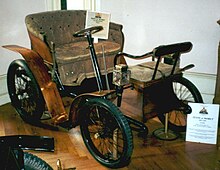Vis-à-vis (carriage)

A vis-à-vis is a carriage in which the passengers sit face to face with the front passengers facing rearward and the rear passengers facing forward.[1] The term comes from the French vis-à-vis, meaning face to face.[1][2]: 28
These carriages are still commonly made by
midwestern United States.[citation needed] Also in the Western world
, the vis-a-vis is the most common type of carriage style used to cart tourists and leisure seekers in downtown urban settings.
Passengers sit back-to-back on
dos-à-dos carriages
.
Examples
The following types of carriage had vis-à-vis seating:
Automobiles

There were vis-à-vis automobiles in the early history of motoring.[2]: 28 These were driven from the forward-facing rear seat, with front passengers sitting ahead of the steering controls and facing the driver.[1][2]: 28 [3] Passengers in the front seat would obstruct the vision of the driver in the rear seat, and the style fell out of favour before 1905.[1][2]: 27-28
See also
Wikimedia Commons has media related to Vis-à-vis automobiles.
- Horse-drawn vehicle
- Car body styles
References
- ^ LCCN 2002014546.
- ^ ISBN 0854292179.
- ISBN 978-1-845845-83-4. |page=484
